Despite wide speculation over whether an en primeur campaign could proceed at all in 2020, this year’s campaign is now more or less complete, and Wine Lister’s scores are in. Bordeaux 2019s exhibit high quality across the board, receiving frequent comparison with recent great vintages – 2016, 2015, 2010, and 2009.
Wine Lister has now published its latest Wine Leagues on the new vintage – examining which Bordeaux 2019s rank best for WL score in each major appellation.
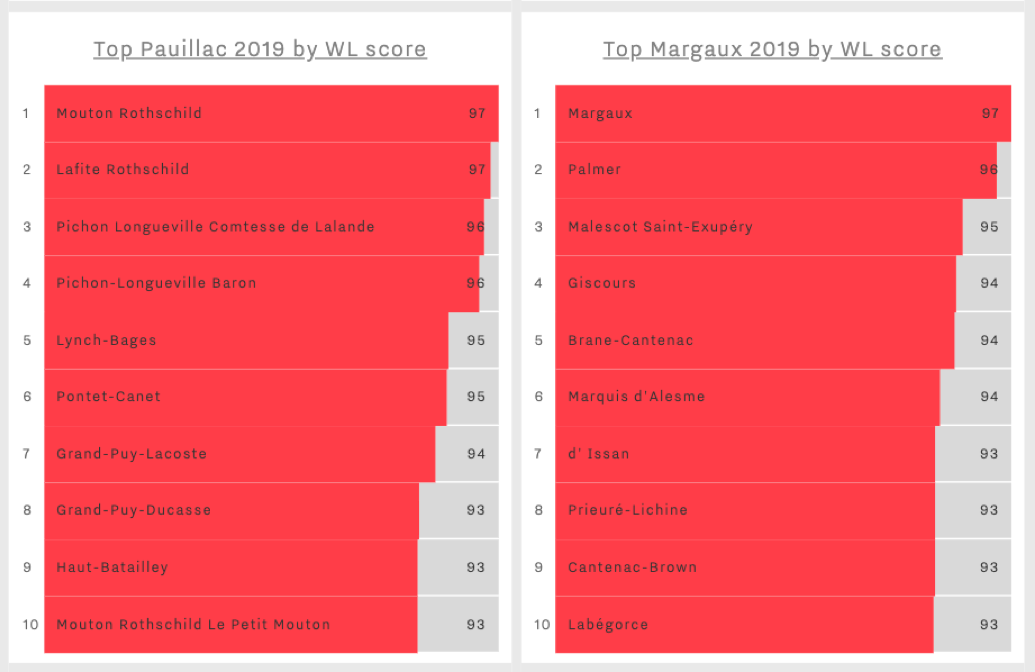
Pauillac First Growths, Lafite and Mouton, lead the appellation’s league of top 2019s by WL score, with a joint score of 97. Pichon Comtesse and Pichon Baron follow suit with 96 – the latter achieving its highest WL score since its 2016 vintage. Wine Lister partner critic Neal Martin describes Pichon-Baron 2019 as having “a very refined bouquet” and a “silky smooth, creamy texture”, stating it “retains all the classicism you could ask for”.
The league of Margaux 2019s by WL score is topped by the appellation’s namesake property, whose latest release joins fellow Pauillac Firsts with a score of 97. Following Palmer’s entry with 96, Malescot Saint-Exupéry 2019 achieves the château’s highest ever WL score (95). Wine Lister partner critic, Antonio Galloni notes that the 2019 is “a striking wine that is sure to find many admirers”, recounting an “interplay of earthy and savoury notes with rich, dense fruit… utterly captivating”.
There are four Value picks featured in the league of Margaux 2019s by WL score, with Labégorce, Malescot Saint-Exupéry, Marquis d’Alesme, and Prieuré-Lichine all achieving scores of 93 and above, at under £35 per bottle (in-bond).
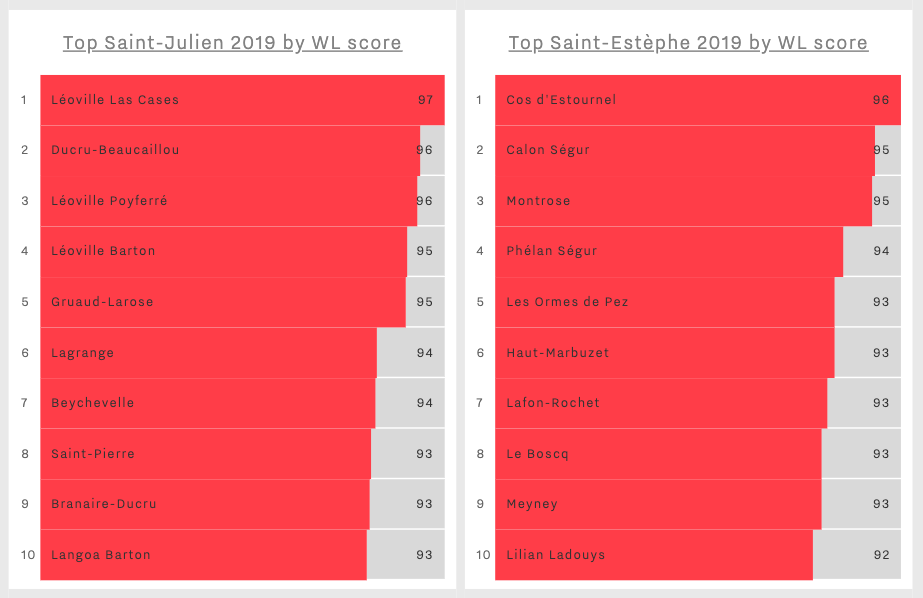
In Saint-Julien, Léoville Las Cases 2019 achieves a WL score of 97, matching that of its 2018 and 2016 vintages. Ducru-Beaucaillou and Léoville Poyferré appear in joint-second place with 96 – achieving their highest WL scores since 2016 and 2015, respectively. Ducru-Beaucaillou 2019 performed notably well at tastings, with Neal Martin, awarding it 96-98 points. He notes its “filigree tannins, pitch perfect acidity and a sensual, satin-like texture”, concluding that the wine is “outstanding in terms of persistence”.
With a score of 96, Cos d’Estournel 2019 tops the league for Saint-Estèphe 2019s by WL score, matching its successful 2018 and 2016 vintages. Writing for JancisRobinson.com, James Lawther describes the vintage as “powerful but carefully constructed and precise”, noting “a lovely mellow quality to such a muscular wine”. While both falling one WL score below their previous vintage, Calon Ségur and Montrose appear second in the appellation’s league, with a shared score of 95.
Branaire-Ducru 2019 and Meyney 2019 exhibit notable value within their appellations – both achieving WL scores of 93 at £29 and £19 per bottle (in-bond), respectively.
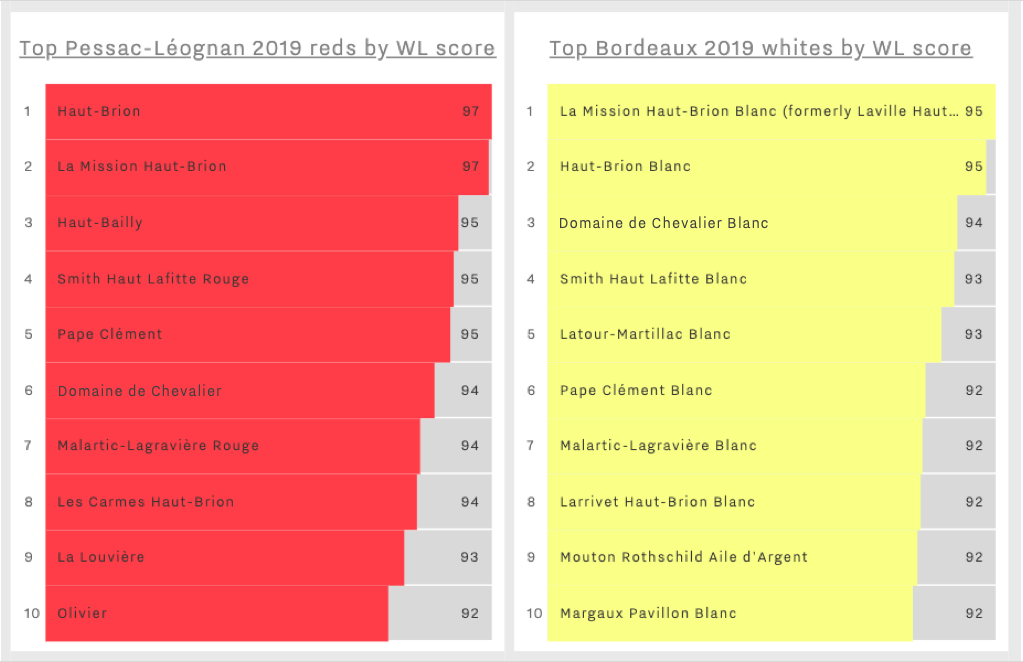
Haut-Brion and La Mission Haut-Brion perform notably well in 2019, achieving joint-first place in the league of top Pessac-Léognan 2019 reds by WL score. As examined in a previous Bordeaux 2019 en primeur blog, the en primeur darling, Les Carmes Haut-Brion, shows clear qualitative success in 2019, and its small production levels and smart en primeur pricing has once again made it a clear campaign buy. Another promising pick from Pessac-Léognan, Olivier 2019 achieves Value pick status at c.£20 per bottle (in-bond), and achieves the château’s highest WL score (92). Antonio Galloni recounts “smoke, licorice, cured meat, graphite and savory herbs infuse the 2019 with striking aromatic intensity to play off its sumptuous fruit”, concluding that the wine is “Very good”.
Haut-Brion and La Mission Haut-Brion attain joint-first place for their whites as well as reds in 2019, achieving scores of 95 in the league of top Bordeaux 2019 whites by WL score. Latour-Martillac Blanc 2019 achieves the highest WL score seen across its vintages (93) – one WL score above Pape Clément Blanc’s 92. At c.£21 per bottle (in bond) Latour-Martillac Blanc 2019 enters the market 10-30% below the current market prices of vintages 2016-2018, showing good value for its quality. Neal Martin notes on the latest vintage: “subtle tropical notes of pineapple and orange rind with hints of strawberry come through on the finish”.
On the right bank, the league of top 10 Saint-Emilion 2019s is crowned by Figeac’s high-scoring 2019. Up one point on its 2018, Figeac’s latest release achieves the highest WL score of all Bordeaux 2019s (98). Figeac 2019 illustrates the château’s impressive upward quality trajectory, which has seen its WL score slowly but surely increase from 91 in 2008. Neal Martin gives the latest vintage 97-99 points, describing it as “exquisitely defined… a deeply impressive, intellectual Figeac”.
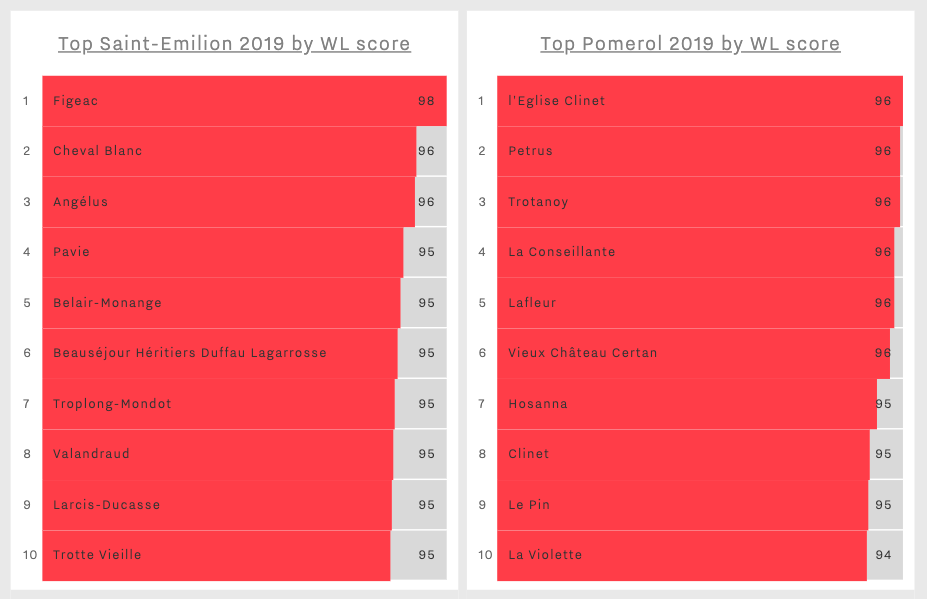
La Conseillante, Lafleur, l’Eglise Clinet, Petrus, Trotanoy, and Vieux Château Certan share the top WL score of Pomerol 2019s (96), separated by mere decimals. A release of note, l’Eglise Clinet 2019 is the last vintage of the late Denis Durantou, who sadly passed away in May. Neal Martin’s impressive score of 97-99 suggests the last vintage was his best, adding, “the perfect way to remember and raise a toast to one of Pomerol’s finest vignerons”.
Click here to view all Wine Leagues. Pro users have access to a more extensive set of Leagues and can log in to access here.
The final stretch of en primeur releases came yesterday – Tuesday 23rd June (excepting Petrus and Le Pin, which are generally always released at the end of the campaign).
First out of the blocks was the en primeur darling, Les Carmes Haut-Brion. Wine Lister’s CEO, Ella Lister, believes Director, Guillaume Pouthier and his team have produced another stunning effort in 2019, continuing their streak of achieving consistently high scores from critics since the 2014 vintage. She names the wine “heady” and “hypnotising” with aromas of “dark fruit, graphite, and mature roses” on the nose. On the palate she describes the wine as “silky, seductive, and generous”, adding that it is “incredibly pure”.
Aside from Les Carmes Haut-Brion’s clear qualitative success, the additional factors of its small production levels and smart en primeur pricing once again make it one of the most obvious buys of the campaign. One top UK merchant tells me, “we sold out in a matter of seconds”. The bittersweet irony of its huge demand is, of course, that it is reserved only for the lucky few. Indeed, its popularity has soared since the release of the 2016 vintage, which has more than doubled its price since. Its impressive price performance post en primeur release (the 2019 released at £58, 28% below the current price of the 2018) is the cherry on Bordeaux buyers’ favourite cake – Les Carmes Haut-Brion is, perhaps unsurprisingly, the number one Bordeaux wine voted by the trade to have seen the sharpest rise in demand, as shown in the chart below.
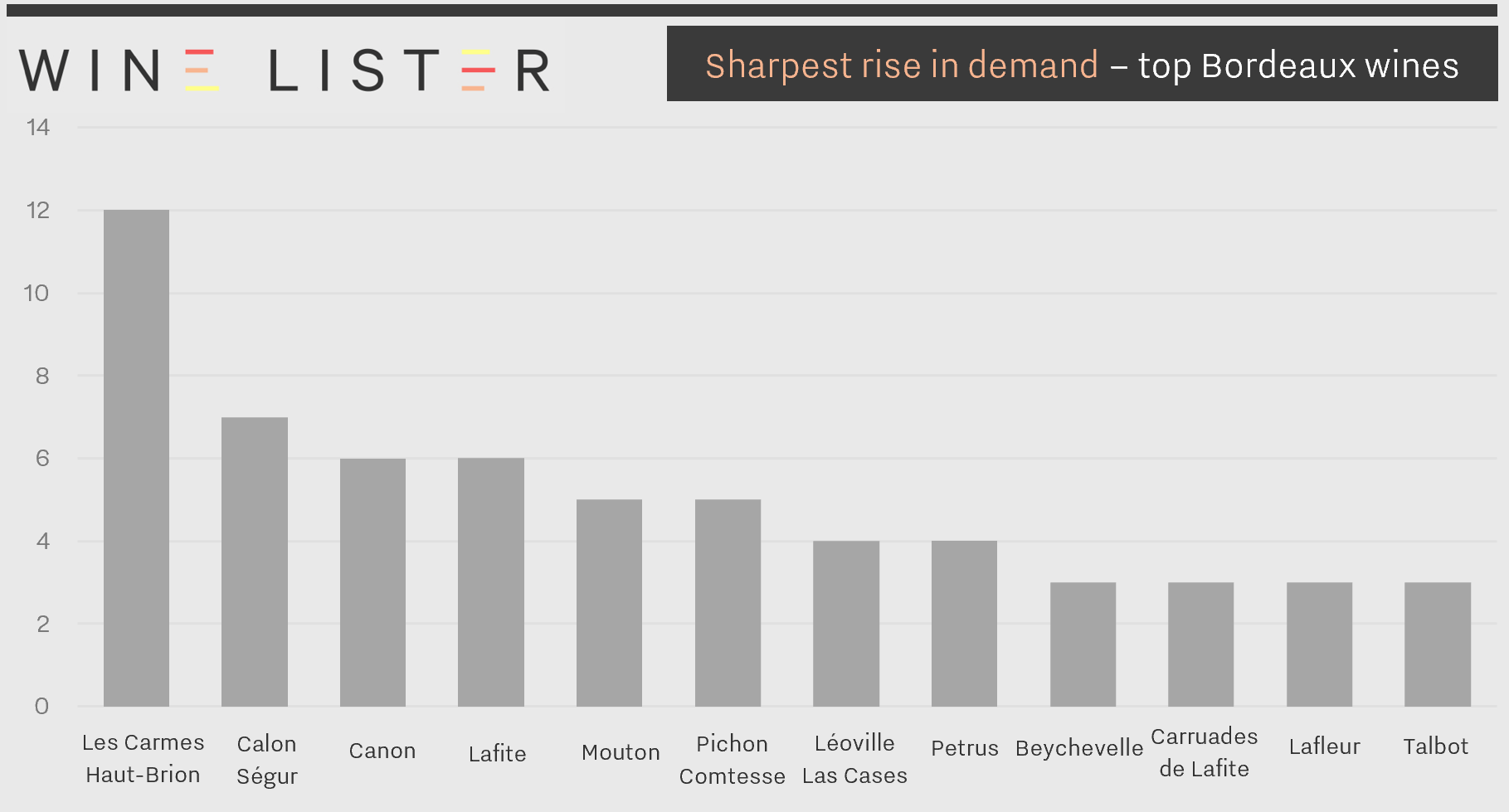 Results from Wine Lister’s 2020 trade survey show Les Carmes Haut-Brion achieves first place for sharpest rise in demand of Bordeaux wines.
Results from Wine Lister’s 2020 trade survey show Les Carmes Haut-Brion achieves first place for sharpest rise in demand of Bordeaux wines.
Joining the fray of hot ticket releases from yesterday was Vieux Château Certan. Wine Lister partner critics were collectively impressed with the 2019, placing its quality on par with the 2018 (which achieves a WL score of 96). Writing for JancisRobinson.com, James Lawther describes the 2019 as a “classic VCC”, while Neal Martin for Vinous hails it a “brilliant follow-up to the 2018”. Releasing at £177 per bottle (in-bond), the latest vintage comes onto the market 20% below the current market price of the 2018.
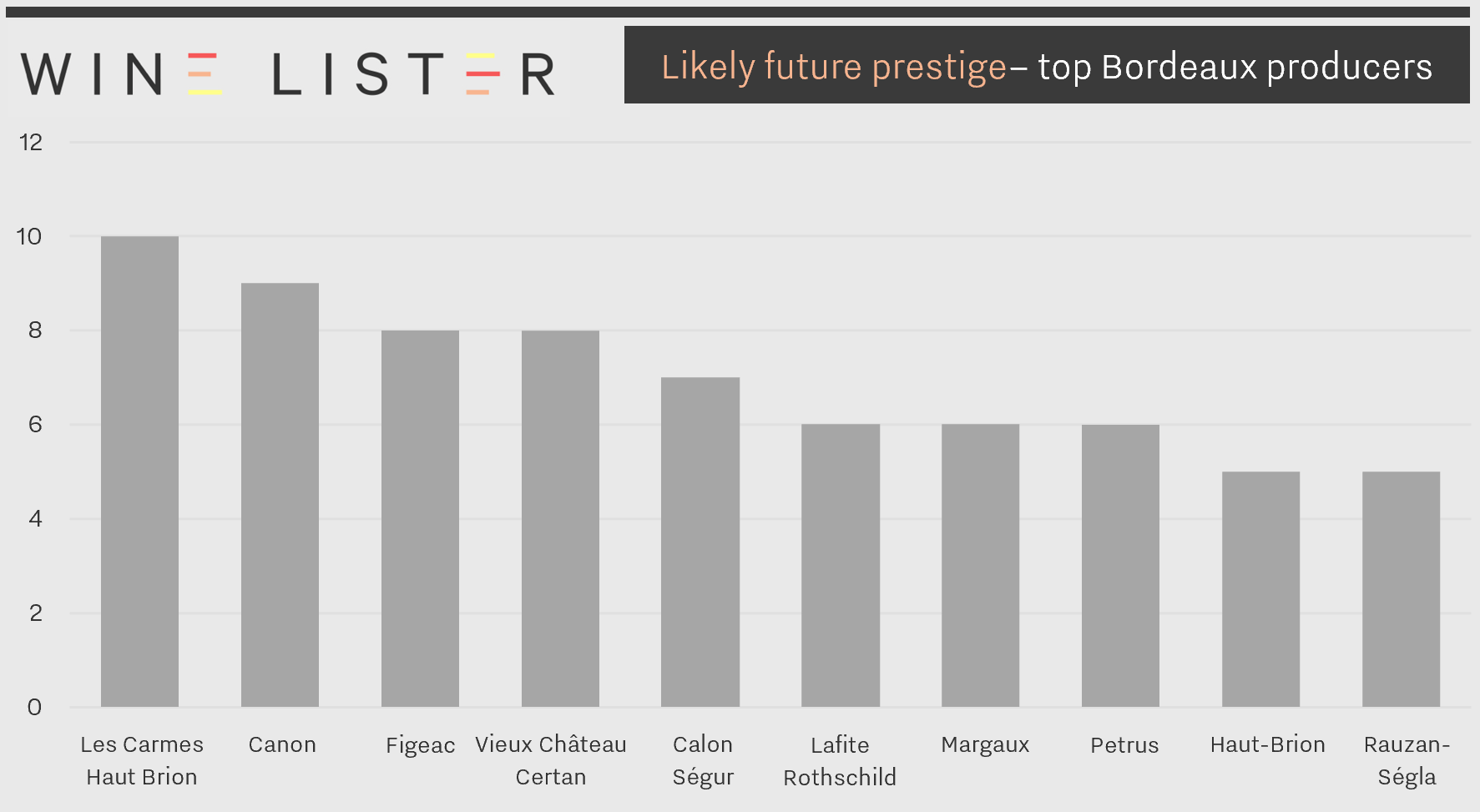 Four releases from Tuesday 23rd June land within the top 10 Bordeaux wines to be voted by key members of the trade as most likely to see future prestige – Les Carmes Haut-Brion, Vieux Château Certan, Canon, and Rauzan-Ségla.
Four releases from Tuesday 23rd June land within the top 10 Bordeaux wines to be voted by key members of the trade as most likely to see future prestige – Les Carmes Haut-Brion, Vieux Château Certan, Canon, and Rauzan-Ségla.
Chanel siblings Canon and Rauzan-Ségla also released their 2019s onto the market yesterday, adding weight to a day full of releases set for bright futures (see image above).
Saint-Émilion star, Canon, released its 2019 to the market at £73 per bottle (in-bond) – 23% below current prices of the 2018 and 2016 vintages. The Canon team characterise 2019 as a “metronome” vintage, referring presumably to the swinging back and forth between climatic extremes. The wet spring and the risk of frost, followed by the strong heat of the summer resulted finally in a perfect finish to the vineyard cycle at the time of harvest, and a wine that sings at perfect pitch. Lister describes Canon 2019 as a “sweet, seductive temptress”, with “voluptuous, racy acidity”, which Director Nicolas Audebert tells us, “2019 is a combination of 2015 and 2016”.
Canon’s Margaux sister, Rauzan-Ségla, also joined the stage, at £57 per bottle (in-bond). A “luscious”, and “lithe” wine, Lister notes the 2019 has “melting fruit, from red to black and back”, and a “toasty, flirty, refined length”. Entering the market 34% below the current price of the 2018 vintage, and offering the second most generous discount on 2018 market prices of the entire campaign (behind only Lafleur), this is sure to see high levels of demand.
 A different time – a throwback to 2018 and a celebration at Château Berliquet, of its acquisition by the Chanel group.
A different time – a throwback to 2018 and a celebration at Château Berliquet, of its acquisition by the Chanel group.
The Chanel group’s new baby, Berliquet, is also growing up fast, releasing its 2019 at £34 per bottle (in-bond). Lister describes “ripe, juicy strawberries” on the nose, adding that it is “very complete, accomplished, and reassuring, with a mineral lift”. On the palate, she finds Berliquet 2019 “rich, full, but very clean-lined”, with “lovely acidity which brings out definition on the finish”. Judging by the immense success of its big siblings, Berliquet has a bright future ahead, and the 2019 is worth snapping up.
Also released yesterday were: Beau-Séjour Bécot and Beauséjour Héritiers Duffau Lagarosse
As we approach the tail end of this busy campaign, the last two working days have seen some promising releases from both banks. Below we examine some of the highlights.
Friday 19th June
Haut-Bailly 2019 was released at £70 per bottle (in-bond), 20% below the 2018 release price. Wine Lister partner critics collectively award the 2019 its highest WL score ever (96), with laudable comments to boot – Antonio Galloni states, “it is easily one of the highlights of the vintage”, while Wine Lister’s CEO, Ella Lister, finds the wine “dark fruited and brooding”, on the nose, and “bewitching, languorous, and layered” on the palate. Haut-Bailly 2019 places second of all Pessac-Léognan reds, after a joint-first WL score of 97 for La Mission Haut-Brion 2019 and Haut-Brion 2019). With a record-high quality, and as a brand on the up, this is a release not to be missed.
Also released on Friday were wines from the Las Cases stable. The flagship wine, Léoville Las Cases, came onto the market at £145.50 per bottle (in-bond) – also a 20% discount from 2018’s opening price. Tasting in Bordeaux two weeks ago, Lister notes the 2019 is “magisterial” with “building power on the finish”. Wine Lister partner critic, Neal Martin, awards Léoville Las Cases 2019 96-98 points, and adds, “there is a clarity to this Grand Vin that places it amongst Jean-Hubert Delon’s finest releases in recent years”.
 Picnic with Director Pierre Graffeuille – Wine Lister’s CEO, Ella Lister, tasted the Las Cases 2019s in Bordeaux two weeks ago, and describes the Grand Vin as “Luminous, transparent, and lyrical”.
Picnic with Director Pierre Graffeuille – Wine Lister’s CEO, Ella Lister, tasted the Las Cases 2019s in Bordeaux two weeks ago, and describes the Grand Vin as “Luminous, transparent, and lyrical”.
Clos du Marquis and Nénin were also released, each offering good value in the context of similar quality wines produced in their respective appellations – Saint-Julien and Pomerol. Léoville Las Cases’ little brother, Petit Lion, is also exceptionally good value.
Perhaps the most notable release of a very busy Friday was l’Église Clinet 2019. Coming onto the market around the same price as the 2018 at £214 per bottle (in-bond), this is a sure exception to the trade’s “-30%” rule, given its circumstances – the last vintage of owner, the late Denis Durantou, who sadly passed away one month ago. Critics’ scores suggest that this final vintage was his best yet – Neal Martin awards it 97-99 points, and notes, “the perfect way to remember and raise a toast to one of Pomerol’s finest vignerons”. For Thierry Desseauve, l’Église Clinet is one of the wines of the vintage.
Pavie Macquin and Larcis Ducasse also released their 2019s on Friday. The former was one of Lister’s stand-out wines in 2019. She describes it as “bright and self-assured” on the nose, and “juicy and unctuous” on the palate. The latter shows particularly well against the wider Saint-Émilion backdrop. Saint-Émilion Grand Cru Classé “B” Larcis Ducasse 2019 earns a WL score of 95 – one point less than the likes of Cheval Blanc and Pavie, and is priced at just £47 per bottle (in-bond), or an average six times less than its Classés “A” comrades.
Monday 22nd June
Pichon Comtesse made for a powerful kick-off to the Bordeaux 2019 en primeur campaign’s fourth (and possibly final) week. Releasing at £111 per bottle, the latest vintage comes onto the market c.15% below the 2018 and 2016 vintages, if at a c.10% premium to the highly-scored 2015. Wine collectors will nonetheless likely be desperate to get their hands on this, given its resounding praise from critics, not to mention the impressive popularity of the estate. A perennial Wine Lister favourite, CEO, Ella Lister notes the wine has “perfectly poised fruit, interwoven with savoury complexity”. Neal Martin awards Pichon Comtesse 2019 98-100 points, and says, “Whisper it…it reminds me of their First Growth next door neighbour”. Dare we say it – this is Latour-level quality for roughly a quarter of the price.
Also released today is Saint-Émilion superstar, Troplong-Mondot. Its 2019 comes onto the market comfortably below the preceding four vintages on the market, with a price of £63.50 per bottle. Continuing the impressive quality increase and style evolution lead by Aymeric de Gironde and his team, critics are impressed with Troplong-Mondot 2019. Antonio Galloni states, “this is a wine that simply can’t be denied”, and Neal Martin agrees, adding that it is “just a wine you are going to want to drink”.
Further releases from Friday 19th June and Monday 22nd June are: Lascombes, Potensac, Réserve de la Comtesse, Smith Haut Lafitte, and Smith Haut Lafitte Blanc.
Faced with a new generation of fine wine buyers seeking more of the “weird and wonderful”, let alone recent economic obstacles – Coronavirus keeping drinkers off the streets, US tariffs on European wines – Bordeaux can struggle to find space to thrive.
Bordeaux’s traditional image compared to more fashionable regions such as Burgundy, Piedmont, or Champagne means its prices are lagging behind. The silver lining is that Bordeaux appears excellent value for the high quality available in comparison.
Wine Lister’s dynamic buy recommendation tool currently identifies 219 Bordeaux wines as MUST BUYs – just 19 fewer than the original MUST BUY list from September 2019.
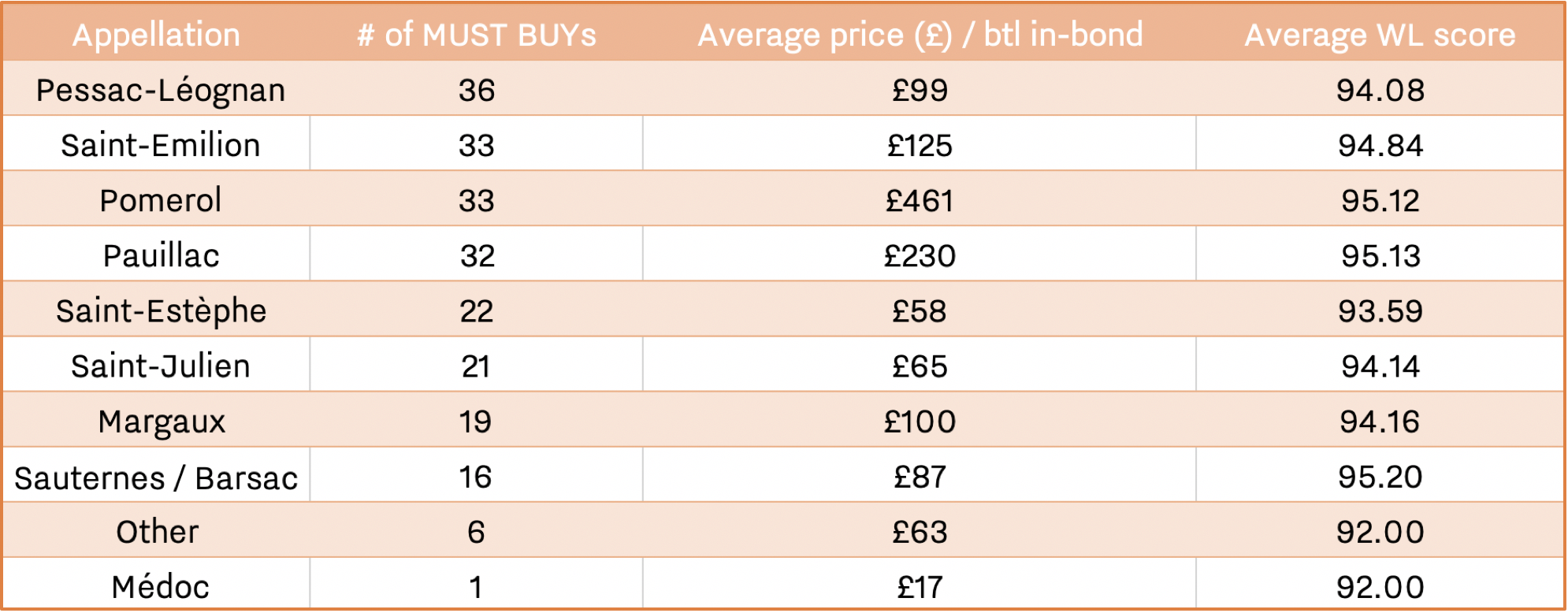
The above table shows each Bordeaux appellation by number of MUST BUYs, as well as average price and WL score of each MUST BUY appellation group. Marking the delayed opportunity presented by slow price evolution post-en primeur, 2016 is the most-featured vintage, achieving 40 entries out of the 219 Bordeaux MUST BUYs (or 18%).
Leading MUST BUY appellation Pessac-Léognan is made up of 28 reds and eight dry whites. Producer Domaine de Chevalier features particularly heavily, earning MUST BUY status for 1981, 2009, 2014, 2015, and 2018 for its red wine, and 2004, 2009, 2010, and 2013 for white. Its second red wine, L’Esprit de Chevalier, appears for the 2016 vintage.
Smith Haut Lafitte and La Mission Haut-Brion share the remaining white places between them, while Haut-Bailly, Haut-Brion, Latour-Martillac, and Malartic-Lagravière achieve multiple entries for reds only. Price-rising superstar Les Carmes Haut Brion features for just one vintage – the 2017.
Right bank appellations Saint-Emilion and Pomerol share second place, with 33 MUST BUYs each. They both earn slightly better average WL scores than Pessac-Léognan, but at prices 26% and 366% higher respectively on average than Pessac counterparts.
The large price difference is hardly surprising in Pomerol, given that its MUST BUY hoard includes five vintages of Petrus, and one of Le Pin. Without these, the average price of Pomerol MUST BUYs is £171, and there are still options at the more affordable end (such as 2016 Vray Croix de Gay).
Powerhouse Pauillac comes next, and includes 14 first growth entries. Mouton takes the lion’s share of these, featuring seven vintages from 1996-2018. Latour earns five places (including one much older vintage – 1964), and Lafite two. Pichon Comtesse also features heavily, earning five MUST BUYs for its grand vin, and one for the Réserve de la Comtesse.
In terms of pure value for money, the one MUST BUY from the Médoc appellation – Potensac 2018 – wins out, followed more generally by Saint-Estèphe’s 22 MUST BUY entries. Perhaps unsurprisingly, its crowned king is Calon Ségur, earning MUST BUY status for five vintages – 2005, 2009, 2014, 2015, and 2016.
Explore all 219 Bordeaux MUST BUYs here.
2017 was perhaps the most difficult of recent Bordeaux vintages. Looking back at our harvest report on this frost-ridden vintage, the Wine Lister team attended the annual UGC re-tasting with some trepidation last week.
Indeed, new president of the Union des Grands Crus Classés, Ronan Laborde, reminded us that 2017 had been a “vintage of challenges”, requiring “patience, determination, and energy” to battle against the frost. Even still, some producers lost their entire crop, and many that didn’t produced their “smallest quantities of recent years”.
Troubled though the vintage might have been, you wouldn’t know it from the hoards of London trade that flocked to taste Bordeaux’s latest deliverable vintage, nor indeed from many of the wines we tasted, which followed a general trend of being exceedingly approachable.
Out of some 120 wines tasted, the Wine Lister team highlights its selection of 17 top dogs, and four underdogs below.
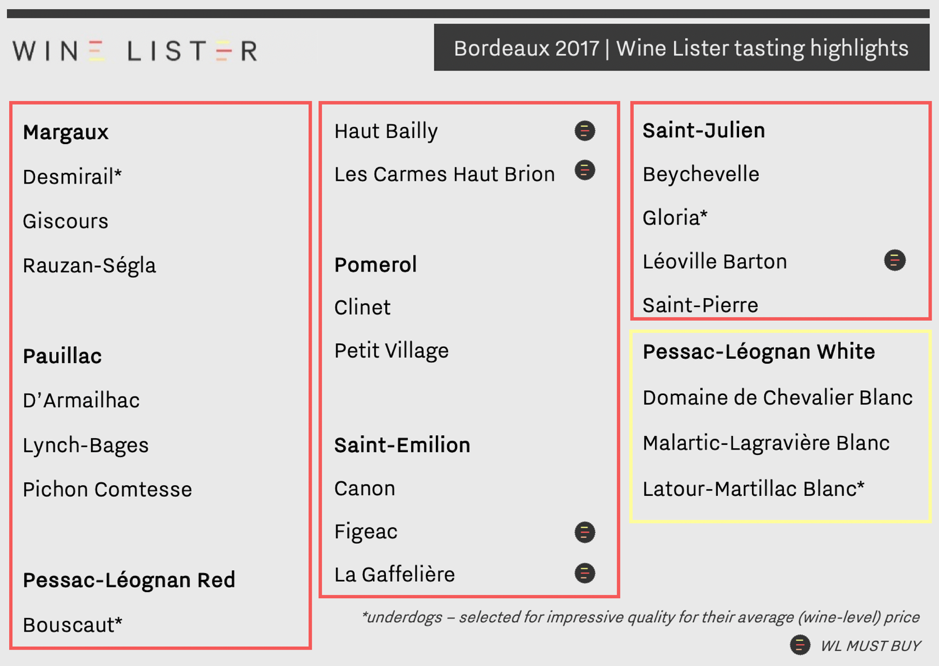
The team’s highlights include five out of the six 2017 Bordeaux WL MUST BUYs (vs. 19 in 2018 Bordeaux), while the other 16 are those we felt showed the best of those in attendance at the UGC tasting, in the context of the 2017 vintage.
Saint-Julien was our top-performing red appellation, with exemplary wines such as “poised” Léoville Barton, as well as two great successes from Domaines Henri Martin: Saint-Pierre was a “real triumph in the vintage,”, while underdog Gloria was “lithe, lovely, and beguiling”. Elsewhere on the left bank, Margaux and Pauillac earn three highlights apiece, including “hedonistic” Giscours and Wine Lister’s top pick of the tasting, “magical, brooding” Pichon Comtesse.
Pessac-Léognan performed equally well for whites as reds. Domaine de Chevalier Blanc was “explosive yet precise”, and underdog Latour-Martillac Blanc showed impressive roundness and balance. Haut Bailly had “an incredible elegance”, while Les Carmes Haut Brion showed “purity and savoury spice”.
Saint-Emilion’s Figeac was the best of the right bank bunch – “muscular” in texture but balanced by “succulent fruit”. Pomerol was well-represented by “floral and velveteen” Clinet, and “powerful” Petit Village.
Other wines included in Wine Lister’s 2017 tasting highlights are: Rauzan-Ségla, D’Armailhac, Lynch Bages, Bouscaut, La Gaffelière, Canon, Beychevelle, and Malartic-Lagravière Blanc.
Yesterday we examined Wine Lister founder, Ella Lister’s top left bank picks from the recent re-tasting of 204 Bordeaux 2016s, now in bottle.
Almost as many wines stood out across appellations on the right bank, from a tasting the following day of 171 wines – testament to the fantastic quality available across the board in 2016. There is no doubting 2016 is a great vintage in Bordeaux. Tasting these wines from bottle only served to confirm the Wine Lister team’s enthusiasm during en primeur tastings in the spring of 2017. Revisit our blog post from the time for details of the unusual weather conditions behind this vintage.
Wine Lister right bank highlights include 11 Saint-Emilion wines vs. 10 in Pomerol, and the top pick overall was Figeac, which was “intellectual”, “fine-boned” and “gourmand”.
Several of its well-known Saint-Emilion neighbours also made the cut into Wine Lister tasting highlights, including Canon ( “feather-light, but generous”), Clos Fourtet, and La Gaffelière.
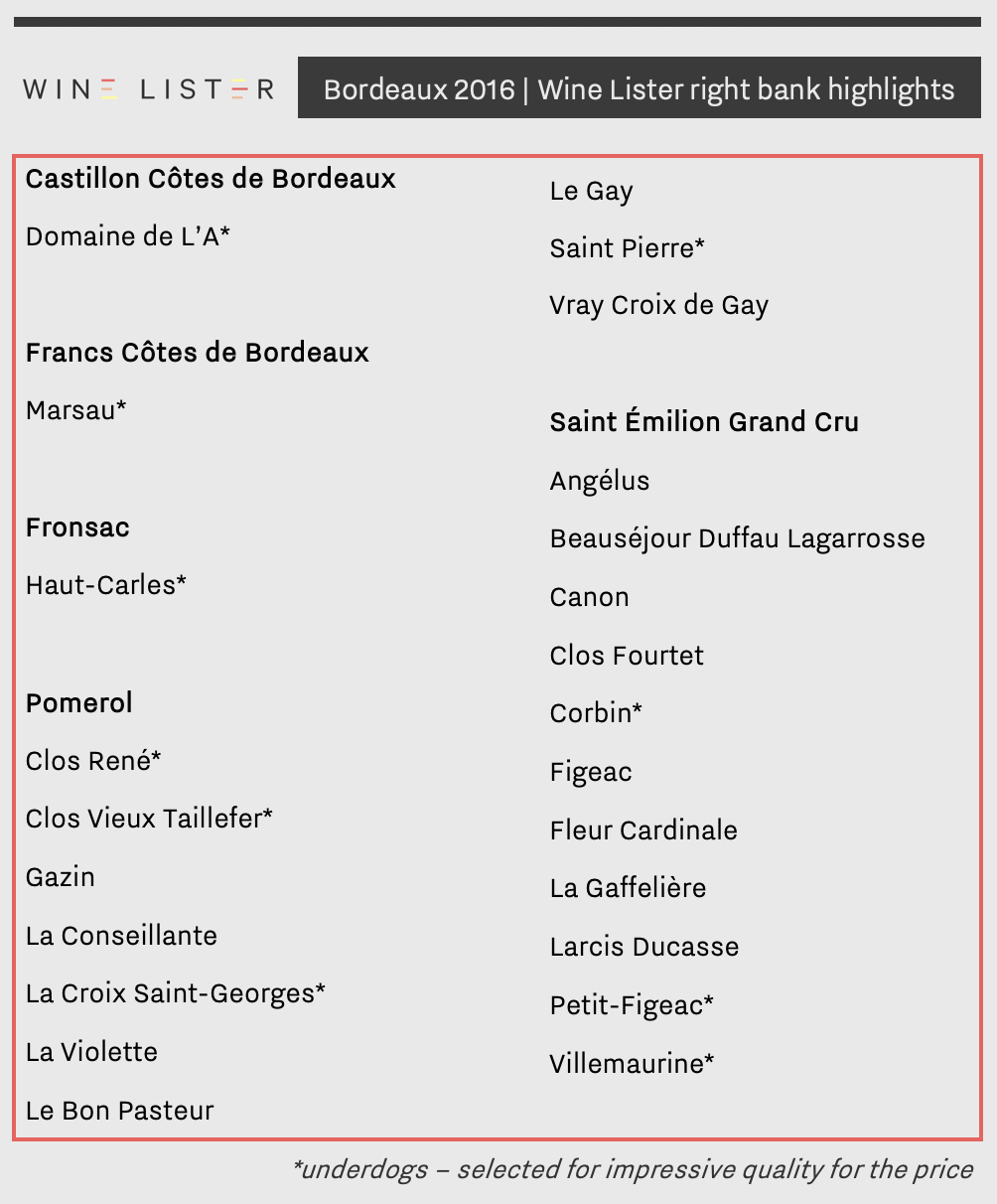 N.B. The tasting did not include wines such as Petrus, Le Pin, Vieux Château Certan, Trotanoy, Ausone, Cheval Blanc, or Pavie.
N.B. The tasting did not include wines such as Petrus, Le Pin, Vieux Château Certan, Trotanoy, Ausone, Cheval Blanc, or Pavie.
However, it was Pomerol that produced more “underdogs” than its neighbour: not-so-big names punching above their weight. Of particular note were Clos Vieux Taillefer and La Croix Saint-Georges.
Among Pomerol top dogs, La Violette was showing beautifully, with a “delicate, fresh” nose and “unctuous, satin” palate. Vray Croix de Gay was “refined” and “thoroughbred”, while La Conseillante produced a “gorgeous, fine-grained texture”.
Further afield, Domaine de l’A from the Côtes de Castillon impressed, as did Marsau, from Francs Côtes de Bordeaux.
Also included in Bordeaux 2016 right bank picks were: Gazin, Saint Pierre, Le Gay, Beauséjour Heritiers Duffau Lagarrosse, Larcis Ducasse, Angélus, Villemaurine, Fleur Cardinale, Clos René, Corbin, and Petit Figeac.
Ausone 2017 released at €400 ex-château (18% down on 2016), which will likely result in a UK release price of c.£492 (also 18% down on 2016), with a lower Quality score: 969 (vs 987).
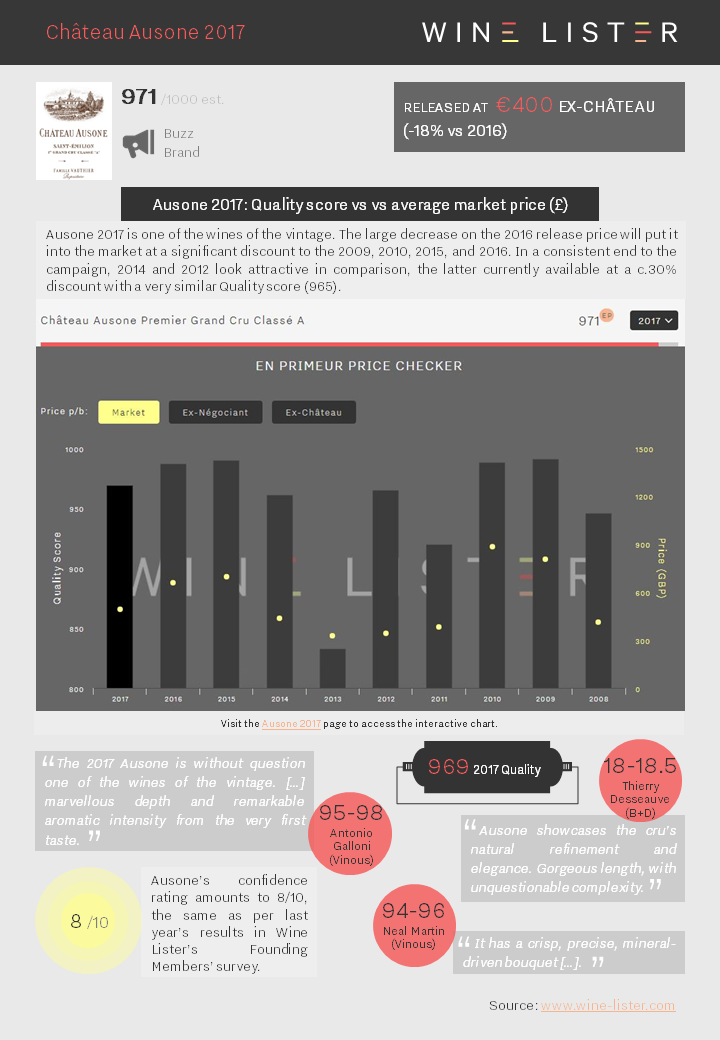
You can download the slide here: Wine Lister Factsheet Ausone 2017
Cheval Blanc 2017 released at €432 ex-négociant (22% down on 2016), with a UK release price of £442 (17% down on 2016), and a lower Quality score: 938 (vs 989).
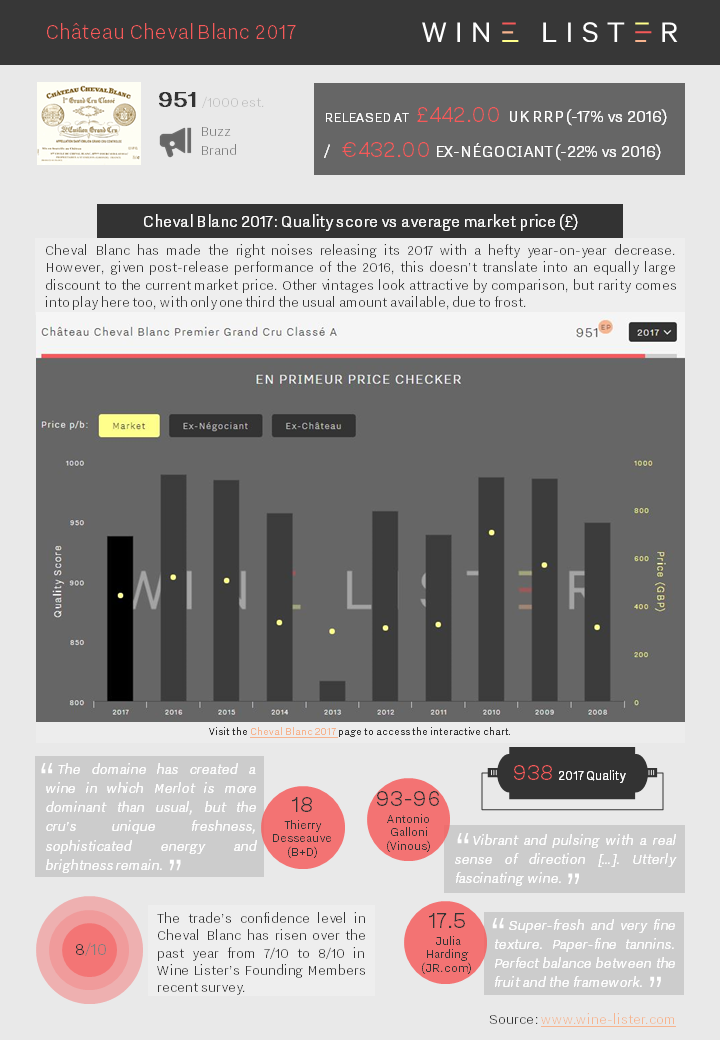
You can download the slide here: Wine Lister Factsheet Cheval Blanc 2017
Angélus 2017 released at €276 ex-négociant (6% down on 2016), with a UK release price of £280 (6% down on 2016), with a lower Quality score: 938 (vs 965).
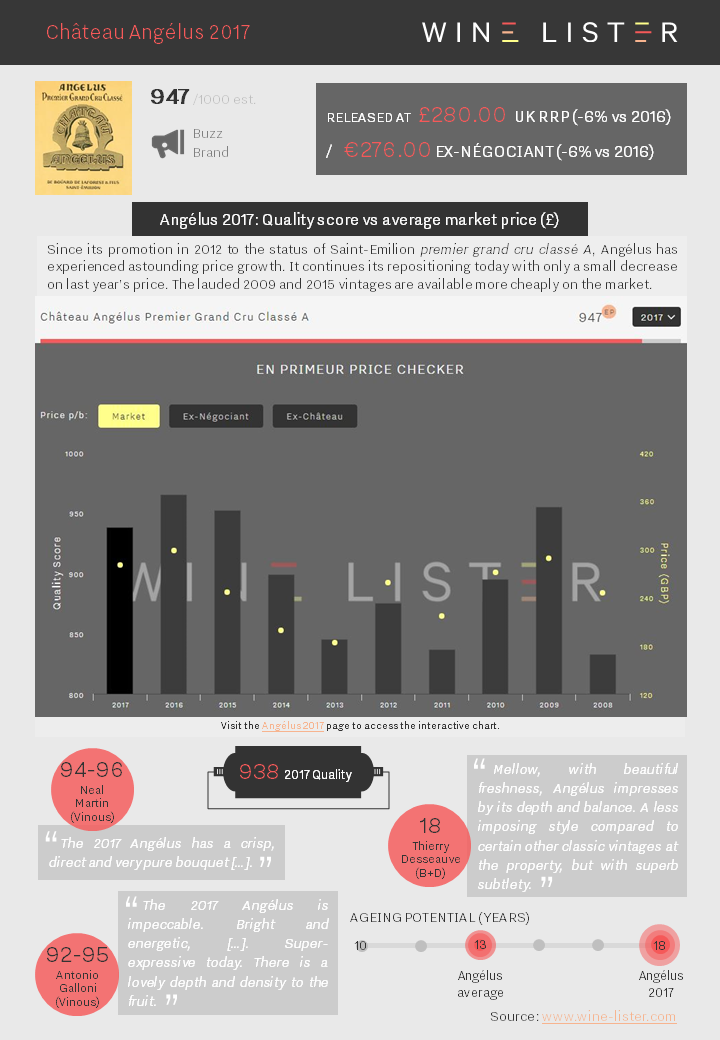
You can download the slide here: Wine Lister Factsheet Angélus 2017
Pavie 2017 released at €276 ex-négociant (6% down on 2016), with a UK release price of £280 (6% down on 2016), and a lower Quality score: 938 (vs 980).
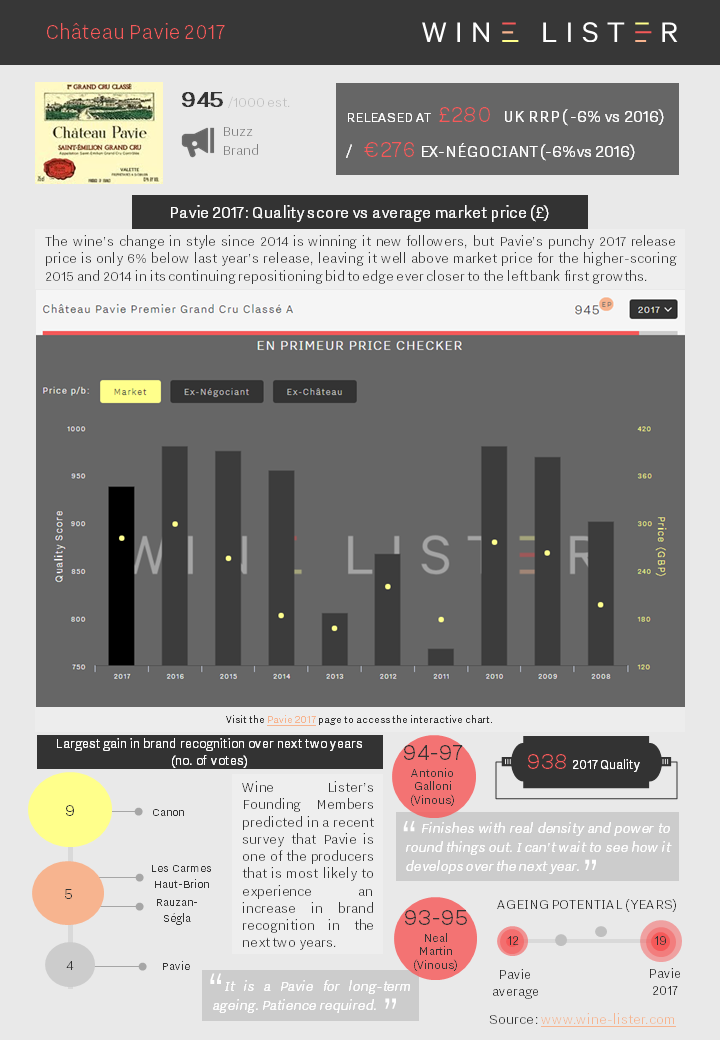
You can download the slide here: Wine Lister Factsheet Pavie 2017




 Results from Wine Lister’s 2020 trade survey show Les Carmes Haut-Brion achieves first place for sharpest rise in demand of Bordeaux wines.
Results from Wine Lister’s 2020 trade survey show Les Carmes Haut-Brion achieves first place for sharpest rise in demand of Bordeaux wines. Four releases from Tuesday 23rd June land within the top 10 Bordeaux wines to be voted by key members of the trade as most likely to see future prestige – Les Carmes Haut-Brion, Vieux Château Certan, Canon, and Rauzan-Ségla.
Four releases from Tuesday 23rd June land within the top 10 Bordeaux wines to be voted by key members of the trade as most likely to see future prestige – Les Carmes Haut-Brion, Vieux Château Certan, Canon, and Rauzan-Ségla. A different time – a throwback to 2018 and a celebration at Château Berliquet, of its acquisition by the Chanel group.
A different time – a throwback to 2018 and a celebration at Château Berliquet, of its acquisition by the Chanel group. Picnic with Director Pierre Graffeuille – Wine Lister’s CEO, Ella Lister, tasted the Las Cases 2019s in Bordeaux two weeks ago, and describes the Grand Vin as “Luminous, transparent, and lyrical”.
Picnic with Director Pierre Graffeuille – Wine Lister’s CEO, Ella Lister, tasted the Las Cases 2019s in Bordeaux two weeks ago, and describes the Grand Vin as “Luminous, transparent, and lyrical”.

 N.B. The tasting did not include wines such as Petrus, Le Pin, Vieux Château Certan, Trotanoy, Ausone, Cheval Blanc, or Pavie.
N.B. The tasting did not include wines such as Petrus, Le Pin, Vieux Château Certan, Trotanoy, Ausone, Cheval Blanc, or Pavie.


